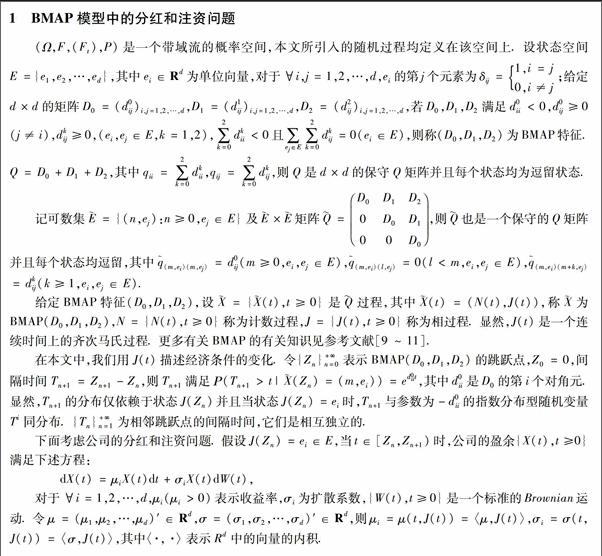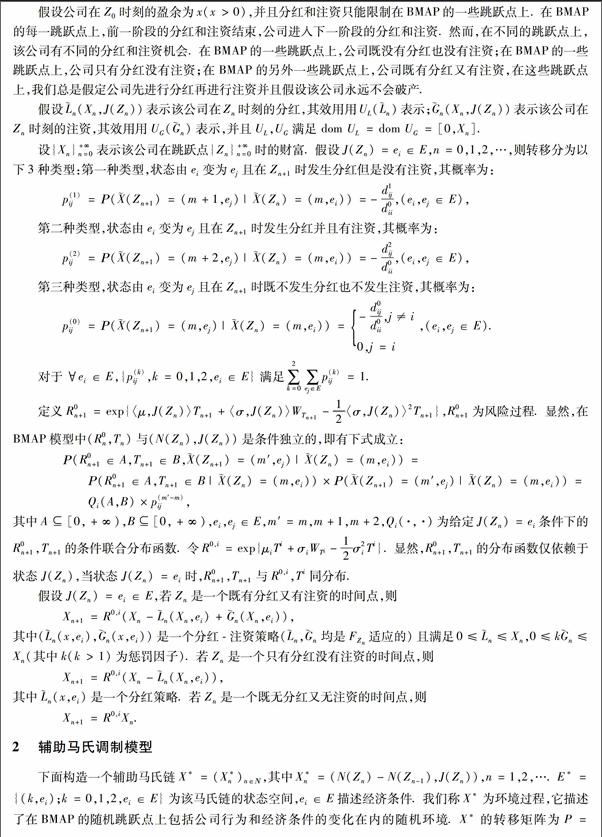BMAP模型中最優分紅和注資問題
白燕飛+陳旭



摘 要 研究了BMAP (Batch Markov Arrival Process) 模型中有分紅和資金注入的情況下,公司的最優分紅和注資問題. 假設公司的盈余過程中的參數由BMAP模型中的相過程調制. 在不同的跳躍點上,該公司有不同的分紅和注資機會:在BMAP的一些跳躍點上,公司既沒有分紅也沒有注資;在BMAP 的一些跳躍點上,公司只有分紅沒有注資;在BMAP的另外一些跳躍點上,公司既有分紅又有注資. 通過將BMAP模型轉化為輔助馬氏調制模型的方法,在公司不破產的情況下,考慮公司的最優分紅和注資問題,旨在使期望折現分紅總量與折現注資量之差達到最大,得到了值函數的精確解以及最優分紅-注資策略.
關鍵詞 BMAP模型;分紅與注資;Bellman方程;Markov決策過程;隨機觀察
中圖分類號 O211.6 文獻標識碼 A 文章編號 1000-2537(2016)03-0062-07
Abstract This paper studies the optimal dividend and capital injection problem of a company in a BMAP (Batch Markov Arrival Process) model. The parameters in the process of the companys surplus are modulated by the phase process of the BMAP, which is an observable continuous-time Markov chain. The possible dividend and capital injection are restricted to some random discrete time points which are determined by the same BMAP. The company has both dividend and capital injection opportunities or only has dividend but not capital injection opportunities at some of these time points, while can do nothing at other random time points. By transforming the BMAP model to an auxiliary Markov modulated model, we study the optimal dividend and capital injection problem of the company under the assumption that the company will not bankrupt. This paper aims to maximize the difference between the total expected discounted dividend and the amount of capital and obtain the exact solution of the value functions and the optimal dividend and capital injection strategy.
Key words BMAP model; dividend and capital injection; Bellman equation; Markov decision process; random observation
近年來,基于金融市場的各種理念與保險市場相結合,利用隨機控制理論以及馬氏決策理論,對保險經營中的再保險、分紅注資和投資優化等一系列問題的研究成為了保險學、精算學以及概率統計學等領域的熱點. 文獻[1]在擴散模型框架下討論了有交易費用的最優分紅和融資問題;文獻[2]討論了有交易費用的對偶風險模型中的最優分紅和資產注入問題;文獻[3]假設資金流由跳擴散過程刻畫,討論了以最大化期望分紅總量為目標的最優分紅問題;文獻[4]在擴散對偶模型下討論了允許交易費用時的最優分紅和注資問題;文獻[5]討論了離散風險模型中有資產注入時的最優分紅問題.
上述文獻所考慮的模型通常是在連續時間下進行觀察,然而,在現實社會中,隨機觀察比連續時間下觀察更為合理. 這使得許多學者對離散時間的模型進行研究. Albercher和Thonhauser首次引入了“隨機觀察”的概念(見文獻[6~7]),在連續時間和離散時間的模型之間建立起了一個橋梁. 文獻[6]研究了隨機觀察下經典風險模型中的Gerber-Shiu函數;文獻[7]研究了隨機觀察下經典風險模型中的期望折現分紅總量. Chen和Yang于2015年首次引入了輔助馬氏調制模型(見文獻[8]),研究了隨機觀察下BMAP模型中隨機時域的最優消費與投資問題. 但是目前隨機觀察下BMAP模型中的最優分紅和注資問題還沒有文獻研究.
受以上文獻的啟發,本文考慮在隨機觀察下BMAP模型中的最優分紅和注資問題. 假設公司不會破產,其盈余過程中的參數由BMAP的相過程調控并假設該公司只能在BMAP的一些跳躍點上才可以進行分紅或注資. 本文旨在使期望折現分紅總量與折現注資量之差達到最大化. 本文第一部分介紹了BMAP的相關基礎知識,描述了BMAP模型中的分紅和注資問題;第二部分構造了輔助馬氏調制模型,給出了該輔助模型下的值函數的表示并給出了值函數的一般解;第三部分給出了在效用函數為冪效用函數情況下值函數的精確解以及最優分紅-注資策略.
參考文獻:
[1] PENG X F, CHEN M, GUO J Y. Optimal dividend and equity issuance problem with proportional and fixed transaction costs[J]. Insurance:Math Econ, 2012,51(3):576-585.
[2] YAO D, YANG H, WANG R. Optimal dividend and capital injection problem in the dual model with proportional and fixed transaction costs[J]. Eur J Oper Res, 2011,16(3):568-576.
[3] BELHAJ M. Optimal dividend payments when cash reserves follow a jump-diffusion process[J]. Math Finance, 2010,20(2):313-325.
[4] AVANZI B, SHEN J, WONG B. Optimal dividends and capital injections in the dual model with diffusion[J]. Astin Bull, 2011,41(2):611-644.
[5] WU Y D, GUO J Y, TANG L. Optimal dividend strategies in discrete risk model with capital injections[J]. Appl Stoch Mod Bus Ind, 2011,27(2):557-566.
[6] ALBRECHER H, CHEUNG E C K, THONHAUSER S S. Randomized observation periods for the compound poisson risk model:the discounted penalty function[J].Scand Act J, 2013:1-29.
[7] ALBRECHER H, CHEUNG E C K, THONHAUSER S S. Randomized observation periods for the compound poisson risk model:dividends[J].Astin Bull, 2011,41(2):45-672.
[8] CHEN X, YANG X Q. Optimal consumption and investment problem with random horizon in a BMAP model[J]. Insurance:Math Econ, 2015,61(1):197-205.
[9] JAMES D C, JEFFREY P K. Batch Markovian Arrival Processes[EB/OL]. http:// www.pitt.edu/~jkharouf/Papers/Cordeiro_Khar_BMAPv0.pdf.
[10] 陳 童,李羚瑋,郭 波. 批量馬爾科夫到達過程概述[J].數學的實踐與認識, 2009,39(17):128-137.
[11] LUCANTONI D M. New results on the single server queue with a batch Markovian arrival process[J].Stoch Mod, 1991,7(1):1-46.
[12] BUERLER N, RIEDER U. Markov decision processes with applications to finance[M].Berlin: Springer, 2011.
(編輯 CXM)

